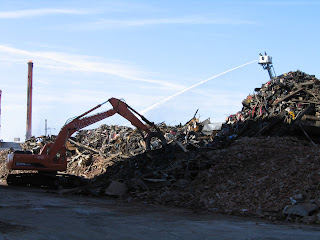
On February 26-27, 2009, the Professional Abatement Contractors of New York (PACNY) held their 13th annual Environmental Conference at the Turning Stone Casino and Resort in Verona, New York. If you have attended this conference before you already know that PACNY does a great job of inviting individuals to speak on current contractor/consultant issues and/or current regulatory issues. In what has become a tradition for the conference, the focus of the second day was the New York State Department of Labor (NYS DOL) and what was affectionately referred to as the Chris Alonge Road Show.
Over 200 people attended the conference this year, not a bad number considering the condition of the economy. However, this year the absence of downstate contractors/consultants was particularly noticeable. It was too bad, because this year’s conference was one of the best. The Mohawk Room had nearly 30 vendors including Grayling Industries, DiVal Safety, Aramsco, and Fiberlock Technologies. Aramsco‘s booth was showcasing a new piece of equipment, a floor buffer with an attachment for a HEPA vacuum, that could be used under the NYS DOL Applicable Variance A-3. This floor buffer with the attachment for a HEPA vacuum would allow a contractor using it to perform mastic removal work with a remote decontamination facility.
All the presentations were held in the Oneida Room. One of my favorite presentations was a two part presentation between Mr. Dale Lesinski, Vice President of DiVal Safety and Mr. Eric Giguere. Mr. Eric Giguere was buried alive in a construction accident and told us his story of survival and his life since his near-death experience. Before Mr. Giguere’s presentation, Mr. Lesinki set the audience up with a Behavior Based safety presentation that worked well with Mr. Giguere’s presentation. The presentation created a powerful 1-2 punch for worker safety. This presentation was so powerful we saw several audience members, including myself, wiping tears away.
The other presentations included:
- Dr. Bruce Lippy’s, of The Lippy Group, presentation on lessons learned from Ground Zero and Boca Raton Anthrax Cleanup. Interesting points: (1) Hazwoper procedures should be an integral part of disasters; (2) Better management of critical incident stress among workers; (3) Better management of the transitions from Rescue to Recovery to Cleanup; (4) Most fatalities involved with work zone safety; (5) Better understanding of the linear relationship between extended work schedule and worker risk of injury: (a) 18 hours of sustained wakefulness produces a performance impairment = 0.05% of blood alcohol content; (b) 24 hours of sustained wakefulness produces a performance impairment = 0.10% of blood alcohol content.
- Mr. Aaron Hilger’s, of the Rochester Builders Exchange, presentation on the recent changes to Wick’s Law (Nassau/Suffolk –increase to threshold from $50,000 to $1.5 million) and the economic climate for the construction industry. His discussion also included current view of the stimulus bill and impact of health care reform.
- LeChase Construction/Eastman Kodak’s presentation involved four speakers (Raymond LeChase, Jr., Darren Yehl, Jim Gerek, & Edward Slovak) point of view of the Eastman Kodak’s Footprint Reduction Program. The program consisted of the remediation – demolition of 80 structures totaling over six million square feet.
On the second day the Oneida room presentations included:
- IAQ Technologies’ Mr. Bob Krell did a presentation on Indoor Environments and Green Buildings that was primarily a mold presentation.
- Lawyers from NYS DOL & Mr. Chris Alonge then discussed: (1) The “Asbestos Successor Legislation” that went into effect in July 2008; (2) The Guidance Document version 2.0; (3) Proposed changes for the Emergency Rule Making of Industrial Code Rule 56.
- The final presentation was a panel discussion including Mr. Chris Alonge. This panel discussion was a Q&A session for the panelist to discuss directly with Mr. Alonge. Audience participation was restricted until after the panelist finished their questions.
All in all the conference was very informative and well worth the trip. It was a pleasure to get together with old friends, make some new ones, and reacquaint with some friends we had not seen in years (Special hello to Patty Kirkland of EMSL). Bravo to the PACNY organization and the committee that put this year’s conference together, they did a great job. We look forward to next year’s conference and hope to see you there next year.





